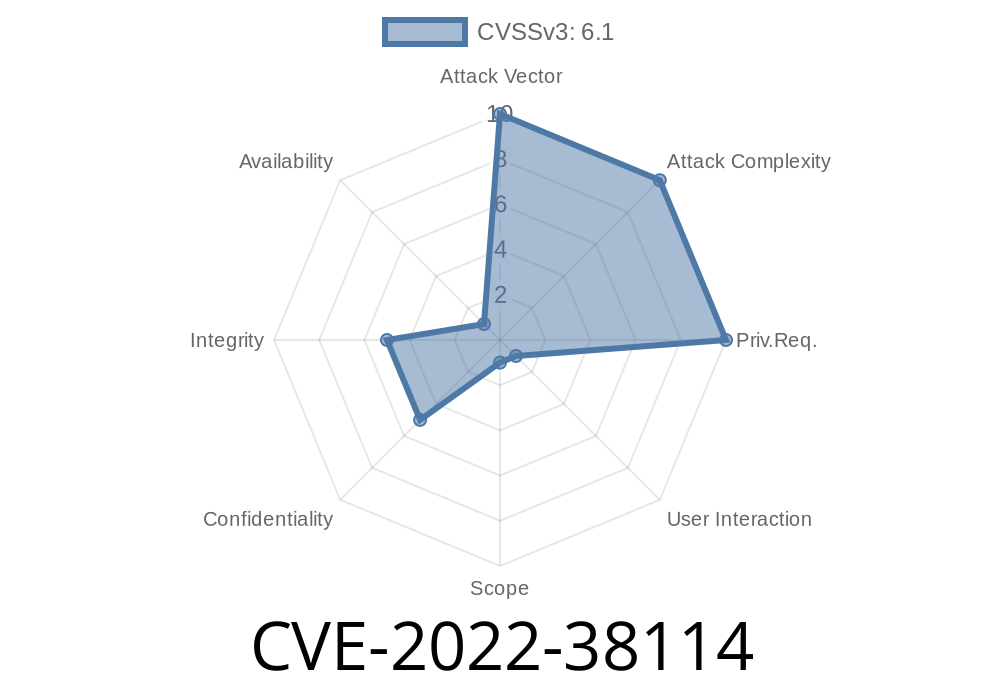CVE-2022-38114 is a recently discovered vulnerability affecting various web servers, which have been identified to incorrectly process the 'Content-Length' header of POST requests. This security flaw makes web applications susceptible to HTTP request smuggling and Cross-Site Scripting (XSS) attacks. In this post, we aim to take you through all the information you need to know about CVE-2022-38114, including the vulnerability details, how it works, and mitigation strategies.
What is CVE-2022-38114?
Common Vulnerabilities and Exposures (CVE) is a list of publicly disclosed information security vulnerabilities and exposures. CVE-2022-38114 is a unique identifier assigned to the vulnerability affecting the processing of the Content-Length header of HTTP POST requests by certain web servers.
This flaw occurs when a web server incorrectly interprets the Content-Length header value, which can lead to HTTP request smuggling or Cross-Site Scripting (XSS) attacks. Both these attacks can have severe consequences for the confidentiality, integrity, and availability of sensitive user data on web applications.
How does it work?
HTTP request smuggling is an attack that abuses inconsistencies in how web servers process HTTP requests. Attackers can exploit this vulnerability by sending maliciously crafted POST requests with ambiguous Content-Length headers. The attacker can potentially inject arbitrary content into the response, leading to a variety of attacks such as data leakage, authentication bypass, and even remote code execution.
Here's an example of an HTTP request smuggling case
POST /example HTTP/1.1\r\n
Host: vulnerable.website\r\n
Content-Type: text/plain\r\n
Content-Length: 6\r\n
Content-Length: 5\r\n
\r\n
ABCDE
In this example, there are two occurrences of the Content-Length header. A web server vulnerable to CVE-2022-38114 might interpret these headers inconsistently. Consequently, it could lead to request smuggling or other malicious behaviors.
XSS attacks, on the other hand, involve injecting malicious scripts into web applications to execute in the victim's browser. By exploiting the Content-Length header vulnerability, the attacker can potentially manipulate the HTTP response sent to the victim's browser, executing the malicious script and compromising sensitive information.
Possible Mitigation Strategies
To protect web applications against CVE-2022-38114, it is crucial to ensure that the web server correctly processes POST requests with Content-Length headers. Here are some ways to achieve this:
1. Check for web server updates: Be sure to regularly check for and apply security updates from your web server's provider. These updates might address vulnerabilities like CVE-2022-38114.
2. Validate Content-Length headers: Implement server-side validation to ensure that incoming HTTP requests include only a single valid Content-Length header. Block any requests containing multiple or malformed Content-Length headers.
3. Use a Web Application Firewall (WAF): Consider deploying a WAF configured to block suspicious HTTP requests, including those with malformed or multiple Content-Length headers.
4. Input validation and output encoding: To mitigate XSS attacks, it is essential to enforce strict input validation and output encoding for user-provided data. This will prevent the injection of malicious code by an attacker.
Conclusion
CVE-2022-38114 is a serious vulnerability that can lead to HTTP request smuggling and XSS attacks. Organizations must vigilantly monitor their web server configurations and promptly apply any available updates to ensure they remain protected from this and other similar security flaws.
Timeline
Published on: 11/23/2022 17:15:00 UTC
Last modified on: 11/28/2022 18:19:00 UTC
